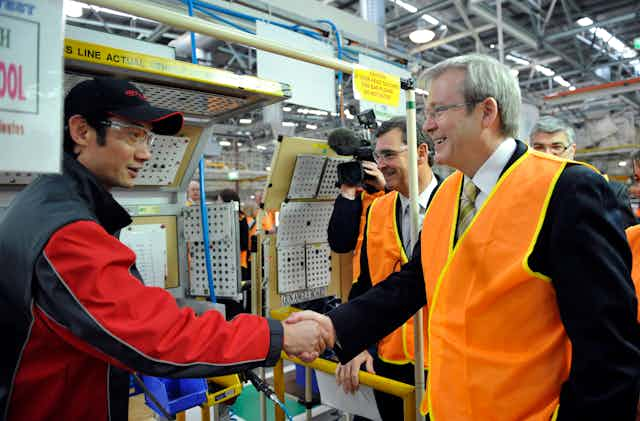Welcome to the **The Conversation Election 2013 State of the Nation* essays. These articles provide in-depth analyses of key policy challenges affecting Australia as the nation heads to the polls. Today, we examine the relationship between innovation and productivity in Australia.*
In his admirable attempt to pack a full term as prime minister into 72 days and as an exemplar of political productivity, Kevin Rudd has indicated economic productivity as one difficult issue he wants to tackle.
Industry and trade unions have been eager to join government to do something about the flat-lining of this most stubborn economic indicator but deep down understand that the solution to the productivity problem is far from simple.
Productivity is the total value of goods and services produced (commonly called the gross domestic product) divided by the inputs (labour and capital) required to create that value.
It is used as a measure of the overall efficiency of the economy. Increasing working hours or making additional capital investments may increase production but it won’t improve productivity unless the value of the outputs increases more than a simple linear relationship would predict.
The economists tell us that working harder is not enough. We have to work smarter, improving the efficiency of our processes and/or increasing the value of the product, to have an effect on productivity.
Two decades ago, Australia was doing very well on the productivity front. Businesses invested in new technologies, the workforce skilled up and management focused on improving quality and increasing the value of their goods or services.
But it seems that the easy gains are over. Investment in new technology, improved skills and better management are now required just to stay in business, with the return on investment more likely to benefit the consumer who wants a lower price despite improvements to the product.
What can rescue us from the clutches of this relentless law of diminishing returns? The most popular answer is “innovation”.
But, as someone who claims to work in innovation, I wonder about the productivity of Australia’s innovation system. Is the value of the output of our innovation pipeline increasing and, if so, is it at a faster rate than the effort and money we invest in it?
Placing a value on research
The research sector is renowned for complaining that there is not enough funding for our research, whether it be from government, the community or business.
But we are less convincing in demonstrating that the increase in research effort from an increase in research funding will lead to more than a commensurate increase in the value of the outputs of that research.
It is difficult, if not impossible, to measure the value of research in purely economic terms. Even the Productivity Commission, not usually daunted by an impossible task, found that it was not possible to provide anything other than broad estimates of the overall return generated by Australia’s investment in science and innovation.
But what about the innovation system itself? How effectively and efficiently are we converting the countless hours spent on research into something of value?
This is the question that drives the discussion around research impact and innovation.
The distance between research in a university, government agency or even in industry and the realisation of the value of that research in an improved product or service, is far greater than the distance between any cup and lip. Indeed, there is no guarantee that the cup will ever come close to the lip for which it was intended.
But that should not stop us considering how we can do better in turning the relentless increase in research outputs into outcomes that make a difference to the world in which we live.
Over the years that I have been involved in research and development, I have witnessed an increasing frustration at the resistance of innovation productivity to improve despite all the effort and well-intended initiatives to make it change.
Some people advocate that we should look to cases where research has led to significant economical value. But does the tortuous path that human papillomavirus vaccine Gardasil took to get to market, or the lengthy legal battles that CSIRO fought to get a financial return on its WiFi research, provide a reproducible or scalable model for the rest of us to follow?
So what can we do?
It is true that there are lots of things we can do to increase the chances that the output of research will produce an economic, social or environmental benefit.
Senator Kim Carr, back at the helm of Australia’s innovation sector, would argue that ensuring good quality research is the first of them.
Close engagement with the potential end-users of the research, and with people who can convert the research output into something that that those end-users can use, is a close second.
There are also things which can decrease the chances. The top three on the list of things we definitely should not do are:
- Overestimating the potential value of the outputs of a particular research project
- Underestimating the difficulty in turning those outputs into products, processes or policies that can be implemented or adopted
- Placing restrictive arrangements around intellectual property that prevent development and deployment ever taking place.
Like the overall productivity of the economy, I don’t believe that there is a quick fix to improving the productivity of the innovation pipeline.
We have to create the garden so the plants can grow. But if - or when - the rain of research funding does fall, we have to accept that there are factors influencing the harvest which are beyond our control.

